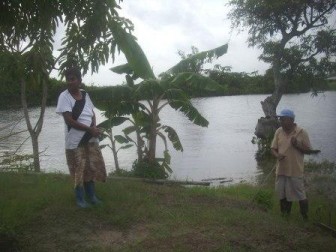The Board of the East Demerara Water Conservancy at 11 am today said that water in the conservancy had reached a threatening level and that a controlled release would have to be made into the Mahaica Creek via the Lama and Maduni sluices.
Such releases have in the past led to deep flooding in Mahaica and the government had been urged since 2005 to ensure that such releases could be avoided.

The statement from the board via the Ministry of Agriculture said “Due to continuous rainfall resulting from the La Nina weather phenomenon, the level of water (in the) East Demerara Water Conservancy has reached a threatening level and still rising. As a last resort, the Commission of EDWC has taken the decision to have controlled release of water through the Mahaica Creek via the Maduni and Lama outlets. Water will be released via the Lama and Maduni Sluices at low tides commencing at 16:00 hrs today.”
The statement said that from the start of the La Nina period, excess water was being released from the EDWC into the Demerara River via the five-door sluice at Land of Canaan and outlets at Kofi and Cunha.
The EDWC Commission urged that all precautions be taken to ensure that the discharge of water did not “acutely aggravate an already rising Mahaica Creek”, due to the “historic level of rainfall along the coast and in the upper reaches which flow into the various creeks and rivers”.
Residents in the upper reaches of the Mahaica and Mahaicony Creeks were urged in the statement to be on the alert and to take precautions in light of the impending release of water to prevent any pressure on the dam.
The board of EDWC has informed the Civil Defence Commission of the decision, the statement said.
“The average level of the EDWC is 57.8 GD which is just above the full supply level of 57.5 GD. The height of the Conservancy Dam is 59 GD”, the statement added.
Critics have charged that the government has not done enough to contain the problem posed by the EDWC since the 2005 Great Flood. The EDWC was believed to be the key factor behind the major flood in 2005 and it forced releases of water into the Mahaica Creek in 2005 and 2006 which led to major flooding in both the Mahaica and Mahaicony creeks.
It has been argued that the government has had six years to address the problems posed by the EDWC but has failed to do this. Its major initiative, the much-criticised Hope Canal – is still in its preliminary stages. It has been argued that the government should have focused more attention on excavating the EDWC, increasing the efficiency of outlets to the Demerara River and improving the internal flow in the conservancy.
The following editorial appeared on February 28, 2011 in this newspaper on the flooding situation:
Six years of marking time
Noting the billions that have been spent on drainage since the 2005 Great Flood, Thursday’s editorial questioned whether it couldn’t have funded a couple of extra pumps for areas inundated after last Monday’s torrential rains.
It was a reasonable question in face of the jeopardy that the East Coast and the city faced last week. Could one day’s rain accumulation – whether it’s six or eight inches – take the East Coast to the brink of the same catastrophe that befell it in 2005? Especially after so much money had been expended in the six years since and the government has trumpeted deafeningly its “successes” in this area? Had the rain persisted on Tuesday and Wednesday and with the spring tides limiting koker operability as they did in 2005 there is little doubt that the coast would again have been mired in the same depth of flood as six years ago. Sheer good luck and drier skies saved the coast from another GDP-gutting disaster that the government has shown it itself incapable of withstanding.
Based on the continuing flood traumas – the most frightening one being this year’s – a dispassionate observer can properly conclude that there has been six years of marking time since the Great Flood. The mountain has laboured at whopping costs to produce a dry-weather mouse and there is much larger expenditure down the road in the form of the much criticized Hope Canal.
The proof of the pudding is always in the eating and last Monday’s rains were the drink that definitively underlined how the annual amounts boasted about in Parliament by each and every minister have failed to construct a viable moat around the vulnerable coast. Up to Friday, Buxton and surrounding areas – like Dochfour of several years before – was still to be relieved of the flooding even though there had been brilliant sunshine and very little rain in the days that followed. And it was only after the publicizing of the plight of the village that two pumps were hurriedly deployed to the area. Wasn’t there supposed to be intensive checks all along the coast to see where bottlenecks existed and to have these immediately targeted? Those entrusted with this task probably went on a walkabout and their minders must have been at sea.
There is no need now for the NDIA to issue a statement setting out in minute detail every single koker that has been fixed, tertiary drain purged of duck weed and labourers marshalled to clear trenches. What it needs to do very succinctly and clearly is to explain to the public why the billions disbursed in the last six years cannot protect the coast from one day’s heavy rain and whether in light of this the expenditure over the last 72 months should be deemed as wasteful and those responsible for the appropriations surcharged.
Leave aside the broader argument about the future of the coast in the face of global warming and the rising seas, there had been expectations that the government would have immediately embarked on the most plausible options following the 2005 flood. Six years later, the showpiece of these efforts – the Hope Canal – is probably a year from completion and it has thus far failed to convince critics that it is part of a long-term solution. Apart from engineering considerations and hydrological factors, critics can easily point to the canal and predict that in time poor maintenance and siltation will defeat its rationale and the search will probably begin anew for another option while a potentially hazardous canal radiates from the troubled conservancy to the sea.
It is the conservancy that should have been the starting point for a well-considered strategy to better protect the coast from days like last Monday. The depth of the Great Flood in front of the conservancy pointed tellingly at it as the main source for the flood through overtopping, seepage and possibly breaches. After many years of not having featured in the flood calculus, the conservancy was/is a real danger to the coast. It was neglect that turned the conservancy into such a threat and which neglect could doom projects like the Hope Canal. Had the governments over the last 30 years really taken maintenance and effective management of the conservancy seriously it would not have been the omnipresent threat that it is now.
Indeed, a World Bank mission in its assessment of the 2005 flooding had this to say about the drainage system. “Over the past several decades, the system has fallen into disrepair due to neglect. Causes of the general deterioration of the system are many and the result has been an increased vulnerability to flooding of inhabited areas north of the Conservancy and Crown dams. Contributing factors include poor maintenance, damaged water control structures, back-filling of canals, uncontrolled development and filling, and backfilling of the conservancy water storage areas due to sedimentation and accumulation of vegetation. These activities have changed the water management regime”.
This was the state of affairs that confronted the government in 2005. There was an urgent need to strengthen sections of the dam, ensure that the current exits operated optimally, desilt the conservancy and open up drainage channels within the conservancy. A very low percentage of these things have been done. Instead the government ponderously set off towards the Hope Canal project which may soon suffer from many of the weaknesses that currently beset the conservancy and with a heavy price tag. It makes little sense.
More frustratingly, several of the experts who had evaluated the Great Flood in 2005 had recommended the virtues of a comprehensive flow study to fully and magisterially plot the way forward in terms of the infrastructure needed to ring fence the coast from these flood events. The same World Bank report unveiled almost six years to the day had said “Before serious material interventions can be realized to repair the depleted drainage system, a flow study would need to be completed. By studying the drainage capacity of primary as well as secondary canals based on water flows, width and depth, an engineer would be able to target specific canals that would be effective in purging excess water. The study could be expanded to include tertiary drainage canals to promote more effective system management within the communities”. This made eminent sense particularly in light of the feverish contestations of the manner in which flood water had circulated in the MMA scheme and in the Mahaicony and Abary creeks in 2005 and 2006. Aside from references in the studies that preceded the finalizing of the Hope Canal there has not been any detailed enunciation in the public of the extent of any such study and the subjecting of its findings to rigorous evaluation by recognized experts.
The subsequent World Bank-funded Conservancy Adaptation Project to reduce vulnerability to catastrophic flooding in the low-lying coastal area was developed to guide a comprehensive upgrading programme for the conservancy and lowland drainage system. It aimed at increasing discharge capacity and improving water level management. The project is scheduled to end in June this year but it is unclear what has thus far been achieved based on last Monday’s flooding.
One of its components was a study for engineering design of works which was to provide the hydrologic baseline necessary for determining interventions to increase the current discharge capacity of the flood control system. How this has beneficially impacted on local works would be of great interest.
It is now too late in the day for this government to drastically change course. One can only hope that the incoming administration will exhibit greater wisdom and display greater respect for sound advice.








